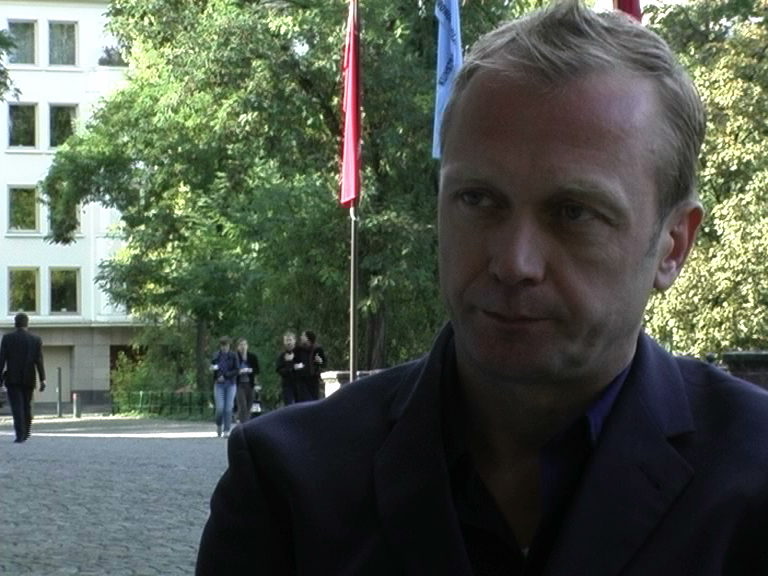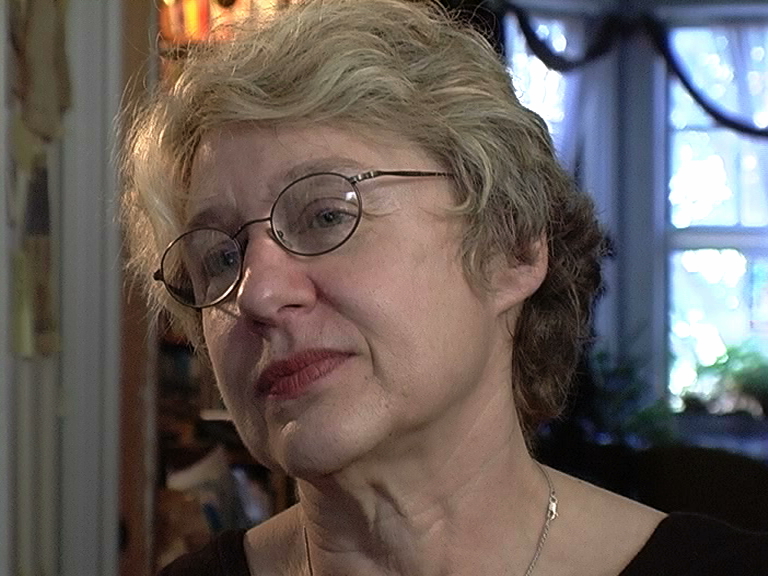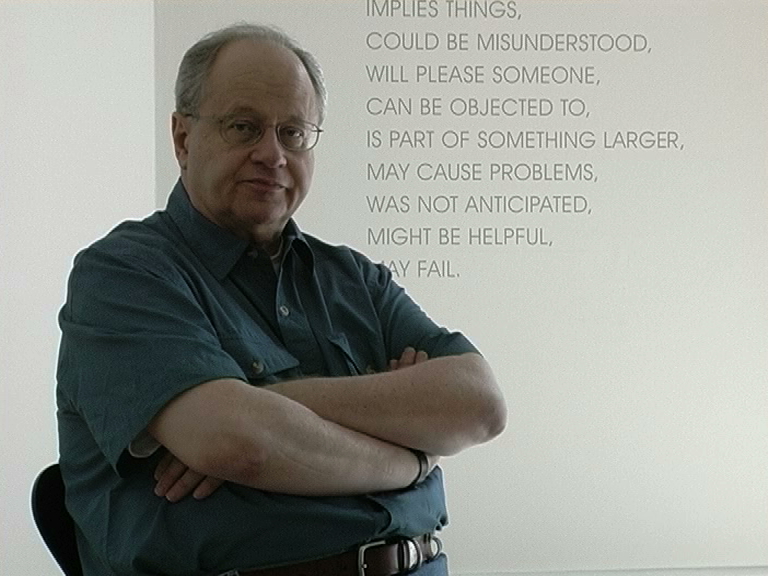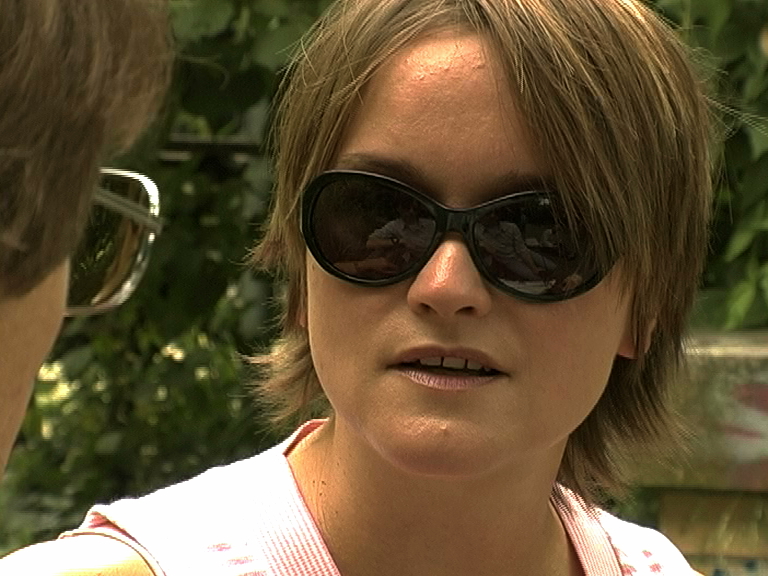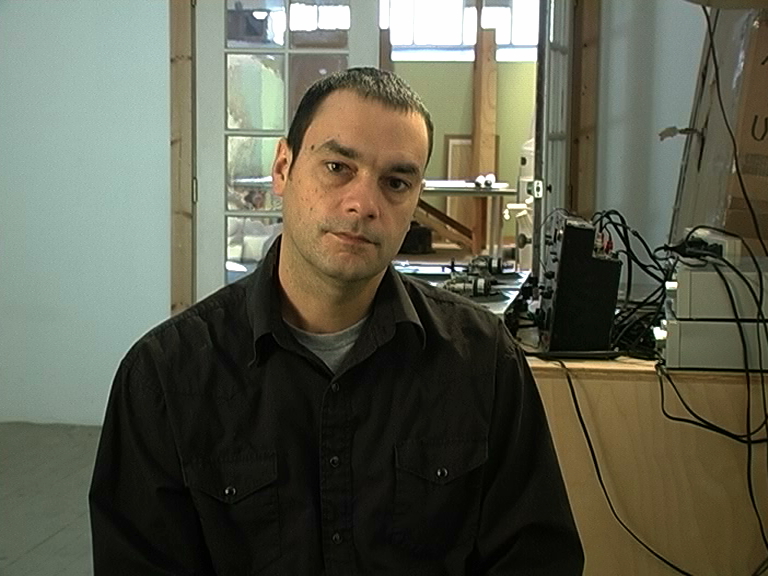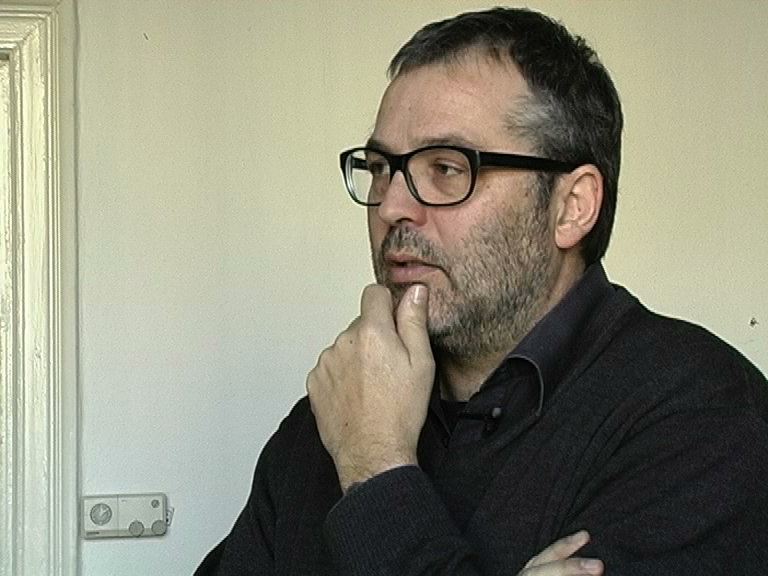S.R.: So, we have Yvonne Rainer in her studio in New York at September 28, 2004. Most groundbreaking in the 1960s was your combination of body and space performance and dance, later on: gender, sex, film. How did you start with that experience bringing these different fields together?
Y.R.: At first, I didn’t bring different fields together. I was a dancer. I was trained as a dancer. I started training in the late 50s. By 1960 I had studied with Anna Halprin on the West Coast. When I came back at that point I met some very influential people who would later pursue their own career. Trisha Brown was in this workshop and Simone Forti. I came back and I started studying with Merce Cunningham, and I studied with him for eight years. In 1960, Robert Dunn started a workshop in the Cunningham studio; Dunn was not a choreographer or a dancer. He was a musician, a musicologist, a philosopher, and his mission was to show us John Cage’s scores and aleatory or chance procedures for making his music compositions and offering these to us with the possibility that we might adapt them to choreography. My first solos were I invented, I created my own movement, but organized the movement phrases by chance procedure. It was an adaptation of John Cage’s score for “Fontana Mix“. And from there, for the next two years by two years, 1962, the members of the workshop realized they had a body of work. And a lot of it was investigation of ordinary movement like looking out the window and incorporating what you saw on the street into your dance, throwing dice. Steve Paxton was very involved with eating; one of his early pieces I remember, I stood in a taped square on the floor and ate a pear. Steve and I used to joke that he invented walking and I invented running; I made a running dance and he made a walking dance. So, by 1962, we went to Judson Church, in the Village, and the church was run by a very radical minister named Howard Moody who had already expanded the usual services of a church: draft counseling. It was the Vietnam war, the beginning of it. They organized around issues of civil rights and free speech. And they had a gallery, they had a poets‘ theatre. And so they invited us in to start making performances, concerts, dance concerts, and we became known as the Judson Dance Theatre.
S.R.: When I go through the documentations, the images, I often see in the underwritings of the photographs that all the people were named who were seen there. I am not so much in this dance field, but is it normal that everybody is named? For me it seems to be that everybody who is involved democratically will get named in the publication, and this is for me something like an aspect that it’s in relationship to art, that there was a strong relationship to art.
Y.R.: After the first concert of dance at Judson we had weekly workshops in the gymnasium of the church. It was open to anybody, and anybody who showed work in these sessions could be on the program. So it was a very open situation. Of course it was limited; it was pretty much a white group of people. Black dancers at that time went to the more conventional and visible dance companies. But, yes, it was a democratic situation, and in the programs, anyone who participated was named. Well, that’s traditional in theatre and dance, and in film; you see the credits roll for five minutes at the end of a film. Everyone – from the caterer to the errand gofer – is named.
S.R.: Let’s move a little bit to the issues, the themes of your work. When I went through the texts I was reading on your work, on your practice, there was cited again and again one quote which caught my interest, and this is the term “avantgarde as resistance,” as you called.
Y.R.: Did I use this term?
S.R.: I read it as a quotation in some texts.
Y.R.: I’ve used the term “adversarial culture” which comes from Susan Sontag. Adversarial in the sense of challenging previous preconceptions and modes of thinking about what constitutes art. We at Judson were very much in the mindset of, I would say – and this is my term – “expanding“ what is allowed through the palace gates of High Art. Of course, that was happening all around us, with Happenings, Pop-art, with Minimal Art – the whole idea of looking outside of previous canons, to what goes on around us in daily life. Pop artists went to commercial icons and the minimalists went to structures, boxes, architecture, and the dancers went to to the way people move in daily life.
S.R.: This is a very important word – daily life. There was another notion that always interested me, it was this statement – I don’t know if you said it like that, but I read it in your statements and in your work: “art practice in and as daily life”, that there was a very strong connection found between how you express something, how you work with your body in space in relation to daily life or as daily life.
Y.R.: As I’ve said, I used to walking, running rather. I would imitate eccentric behavior I saw on the subway and juxtapose this with ballet combinations I had learned that day in ballet class. I was also taking a lot of ballet. So for me it was a matter of radical juxtaposition of the classical and the ordinary pedestrian, as it is sometimes called.
Interruption: cat in bag
Y.R.: (cont.) I was talking about radical juxtaposition – another Sontag term is “radical juxtaposition.” I was interested in juxtaposing what I had learned in Cunningham and ballet class with what is sometimes called pedestrian movement or eccentric kinds of behavior.
S.R.: How would you describe this working situation at the Judson Dance Theatre? Did other artists come to participate?
Y.R.: Yes, absolutely; it wasn’t just dancers. There were artists: Robert Morris, Robert Rauschenberg, Alex Hay; there were composers: Philip Corner, Malcolm Goldstein; there were singers, and there were all kinds of collaborations between – like, a dancer and a painter. Or Rauschenberg, I guess, got his impetus from being around Judson and started by 1965 with doing theater works. Alex Hay was a painter who did performance kinds of things, very funny things. Carolee Schneemann was another participant who used dancers and non-dancers. My running dance and Steve’s walking dance – used all kinds of people with training and without training.
S.R.: So, how do we have to imagine the situation there? How were pieces developed? How did you start working on a piece?
Y.R.: Individually, I got the idea for, say, the running dance. It was called “We Shall Run,” and I asked people to come to rehearsals, and it took two or three rehearsals and then it was ready. A very interesting collaboration took place around 1963 – Charles Ross, Chuck Ross came and proposed that he would build two enormous structures out of wood and aluminum pipe and make them available to us and different people. So we had about two or three evenings in which people did different things with these structures. Deborah Hay did a whole evening of improvisation; there was no structure at all. So, there were different kinds of individual works and large group works. A dancer named Arlene Rothwein; she copied Delacroix paintings. So, she enlisted thirty people to do tableaux vivants based on 19th century painting. There were just all kinds of investigations, experiments.
S.R.: How did you manage the public, the audience. Was it every week?
Y.R.: No, there were maybe two, at the most three concerts a year. Well, more than that. Because the heyday of the Judson Dance Theatre was 1962 to 1965, and then the workshops disbanded. There were concerts in the Judson and outside; the same group of people would go outside of New York even, in some little theaters in New York. Over that three-year period it must have been about 25 concerts.
S.R.: How would you describe the time after that – maybe the 1970s? What happened for you?
Y.R: Well, for me, I began to incorporate more language, speaking, into what I was doing. The women’s movement affected me, I was getting older, not enjoying running around so much, and also I went to India in 1970 to follow the Katakali, the Indian classical theatre. They toured in January in the state of Kerala; they did these open-air presentations, and I spent a month following them. And I came back in a state of cultural shock, but thinking about stories. I mean, the Indian theater, their main interest is with the Mahabharata and the Ramajana, the classical myths of the Indian culture. I was impressed with the way it engaged so many people of all ages who could sit through an all-night concert. I remember sitting beside an eighty-year-old woman who was just enthralled and turtling, and I was going to sleep; I was so tired at two in the morning; and there she was, it was for her. So, I came back and I began to think about my own life, or various pieces of literature – Jung. I made a piece called “Grand Union Dreams” for a group of about twenty, twenty-five people, that separated the performers into gods, mortals and heroes, and this was the first time I began to think about characterization. Before that everyone did the same things – men, women, there was no distinction. There was a lot of recitation; it was like a childlike pageant with readings from Jung, Hermann Hesse – from things people were reading in the 60s.
And by 1972, I was beginning to think about film. I mean, I had made short films between 1966 and 1969; I had made very short, very minimalist kind of films, just focussing on a part of the body, and they were incorporated – like showing – in various ways with dance. Then, by 1972, I was thinking about a feature film, and I met Babette Mangolte who had just come from Paris and was looking at avant-garde art theater and dance. So I began to speak to her about a film; I said I would like it to look like somewhere between Bresson and Warhol; and that first film was called “Lives of Performers”. By 1975, I stopped dancing altogether and moved into film.
S.R.: Would you say that at the same time as you started thinking on characters, … narration, writing, that was the break and you were more involved with drama, film, or representation?
Y.R.: I was thinking more about social content and not so much about the body. I mean dance to me, even when I used speech, the primary focus was the body, and now film offered the possibility of placing the body in some kind of social context – or psychological; even though the overall film does not have a plot, there are short vignettes of stories about relationships, heterosexual relationships. That was my entree into telling stories, in using cinema and the possibility of sound, image, language, print, the possibility of changing the whole field in one 24th of a second.
S.R.: And then you moved more to this issue of gender?
Y.R.: It took a while. Gender really enters in the 1980s, gender and race issues. My third film dealt with oil pollution, the effect of these massive oil tankers going to ground. It’s kind of a picaresque tale: a Jewish lion tamer survives the war, comes to New York after World War II, becomes a choreographer and gets involved with someone who was a sailor on an oil tanker. They have these long dialogues, lying in bed: he talks about life on the tanker, and the change. It’s kind of a romantic disquisition on the change from sailing days and these mechanized, digitized oil tankers that are extremely dangerous and unwieldy, go easily out of control. So, he talks about that, and the lion tamer-turned-choreographer talks about the mating habits of lions. It’s kind of surrealist, somewhat funny.
But by the fourth film in 1985, “The Man Who Envied Women”, gender very much is in the foreground, along with US imperialism, interventions in Central America and artists‘ activism. So, more and more my films took stronger political positions in relation to current, topical issues.
S.R.: How do you reflect the reception of your films in the last 20 years? Is it more in the field of art or is it in film festivals?
Y.R.: It’s interesting. My films, it’s a very specialized audience: film festivals, European, university film departments, small theaters. Then something happened in 2000. Michail Baryshnikov, he had always been interested in downtown dance ever since he defected in the 1970s, and he asked some of the former Judson dancers, choreographers, to revive and make new work for his company – which is called the “White Oak Dance Project”. And I hadn’t choreographed for twenty-five years, and it was an offer I couldn’t refuse. I made a thirty-minute dance called “After Many a Summer Dies the Swan” which is a kind of pastiche. I went back to my trunks and files and excavated – with the help of someone who had studied with me thirty years ago, Pat Catterson – I excavated a whole lot of stuff and put it back together in a totally different way. I mean, very little of my dance has survived – so, it’s memory, it’s photos, it’s notebook, notation – and I patched together a dance with some new material and speaking. That brought me back into the dance fold; I still have a dance called “Trio A”…
Interruption: phone
Y.R. (cont.) … which is from 1966, and it’s the first section of an evening-long work called “The Mind is a Muscle,” which is one of my more famous, well-known titles. But “Trio A” was filmed in 1978 as a solo by me. So, it survived and I continue to do it, and it still is being taught. Just two summers ago, I myself taught it in London, to a group.
So, then, in 2002, Baryshnikov toured with a program called “Past/Forward”, which was a compendium of different works from the period. “Trio A” was done and a couple of other works of mine and other people like … David Gordon, Lucinda Childs, Simone Forti, Deborah Hay, Steve Paxton. What got me into a whole other area of gallery exhibition which I’d always avoided. I have no graphic talent; I’ve always been a little wary of the art world since the 1960s, but I got an idea for a video installation based on the dance material, or using the dance material from “After Many a Summer Dies the Swan”. And then someone approached me in Philadelphia to do an exhibition. At first I balked – “What do I have to show?” – and then I got this idea for this installation. Another slide and prop installation, and then a lot of photos. Sid Sachs, the curator of this Philadelphia gallery came and went to my archive and found all kinds of stuff. So, this show is now going around.
As you see, my work has gone from dance to film, back to dance to gallery installation.
S.R.: What do you consider as your strongest influences?
Y.R.: Early on it would have been John Cage, and Merce Cunningham, to some extent; he certainly was – not an influence –, an inspiration. And during the 1960s, I had followed European film culture from a very early age. Imprinted in my imagination were films of Renoir, Dreyer, Pabst, Vigo. These were my early loves, the films of these filmmakers.
And then, in the 1960s, I followed the so-called “New American Cinema” – Hollis Frampton, Maya Deren, Michael Snow. These people were, I would say, an influence in my short films which I carried with a kind of formal sensibility into the longer films. Warhol was an influence, I would say, the portraits.
S.R.: But you never worked together with him?
Y.R.: No. I knew him.He used to come to the Judson to see the dancers.
S.R.: Is it possible to say that you have or had something like a goal or an aim in your work?
Y.R.: Certainly not a single aim. Each project suggests a new set of parameters and tasks, so to speak, themes. There is no single goal. I think I’m still involved in both using and subverting, utilizing conventions of narrative cinema in my film works, in characterization. My last film, “Murder and Murder”, about two older women who get together – one of them is an academic – I bring in these ghosts, the dead mother of one of them, and the 18-year-old incarnation of the other one; and they are the witnesses and the commentators on what is going on. Sometimes it’s very ironic, their take on things.
So, in every scene which sets up characters and an interplay there is usually some kind of … you can ask, “What’s wrong with this picture?” There is something that doesn’t belong there, either an anachronism or some funny business, a dream or something. The interactions between these two women occur on a stage with an audience. So, I switch back and forth. One of them is a performance artist, so he stage is set up; some of their interaction is in a boxing ring. But it’s also about cancer; one of them gets breast cancer. The floor of the boxing ring, imprinted on it are all these statistics: what are the risks and who is most vulnerable to cancer. So, I’m mixing up information and situation all the time. This is a modus operandi, you might say. The video installation juxtaposes texts about fin-de-siècle Vienna, the clash of art and politics around 1900, with dance footage. There is a constantly shifting relationship between the two. Sometimes the dance stands for the avant-garde of the period, sometimes it mimics what is said in the text. It’s a demanding kind of, I mean, I do not allow the spectators to sit back and send their minds away. Pauline Kael, the film writer, once said: “Only in the movies you can send your mind away”. So, my goal is to reinvigorate, reactivate the spectators‘ critical faculties. I do not allow you to send your mind away when you are looking at a film of mine.
S.R.: Can I say, that you try to involve the individual viewer, that he has to take a position to the issue?
Y.R: Yes, perhaps. To the issue being explored, and also to the way in which it’s being presented; the politics of the subject matter and the politics of the filmmaking process itself, the production itself.
S.R.: I don’t want to talk too much about your single works. As I saw your last film I was reflecting the question, if this kind of involvement that you are constructing in film, if this is influenced by your perspective as a dancer, performing with the body on a stage; I think the reception process in dance is always a little bit about identification. When you sit in the audience. I had the feeling that in your last film there was a specific intensity for this involvement.
Y.R.: Of the spectator?
S.R.: Yes.
Y.R.: Yes. I’m always assessing, whether I am pushing you away or drawing you in. It’s a subjective matter; I can’t say there are rules about this, it depends on who your audience is; it’s very hard to project how one’s work affects an audience. I mean, people walk out of my films, and then there are very devoted followers. But I guess it’s, you address yourself as a spectator, up the ante in terms of what you think will be challenging and supportive in terms of political things.
S.R.: Let’s focus on these political issues of your films. Do you think it’s more because this involvement starts to overpower them or involves them too much psychologically?
Y.R.: No, they get bored. Usually it’s boredom. Something goes on too long, especially in the early films. That’s funny; when my exhibition was in Los Angeles in May, there was a whole lot of things going on at the same time. I shared a concert with Simone Forti. I revived five dancers, and she performed in her own work. Then there were film screenings. In the question-and-answer after the screening of my second film from 1974, “Film About a Woman Who”, there was a fairly large audience, a couple of hundred people; someone asked me. And I sat through it. I hadn’t seen the film for a number of years. So, I sat through it and someone asked me: “How does it feel looking at this work from so long ago?” And I said: “It was unbearable.” I mean, it’s very hard to look at some of those early films. The sense of duration in the 1960s under the influence of John Cage was so much more protracted than our tolerance now which has been conditioned by commercials and mainstream film, quick, quick cutting. A shot that goes on for five or ten minutes – it’s Warhol-style – can be tolerated only by those who are really interested in this history. So, people still walk out of. No, only a couple of people walked out that night, but the rest hung in there – which surprised me.
S.R.: We were discussing some paradigms which I consider specific for the 1960s; maybe till the middle of the 70s. Are these paradigms still in function or are they strongly changing? As you described it with the kind of reception in relation to the kind of fast editing in the 1960s?
Y.R.: In what field?
S.R.: In the filmic, the cineastic field.
Y.R.: I’m thinking of video installations in galleries now where so often there is a single idea. It’s true, it’s a single idea that goes on for five, ten minutes. It’s a return to the 60s; you look at one image with overpowering sound, and it’s huge. I think production values are very much more important now than when I started making films; the glossiness, the large image, the single image that looks like it came out of a mainstream film. Especially visual artists, photographic artists are much more concerned with the photographic quality of the image than I ever was. My films are very crude, even the recent ones.
S.R.: A personal question: What is your ideal typical daily work as an artist?
Y.R.: For the last years, it has been writing; I’ve been writing a memoir which is very satisfying in one sense, because with filmmaking it’s like stop-and-go. You finish a script and then you start looking for money, a crew; the daily work is much more tedious than the creative part of it. For the last year I’ve been writing, and now that’s coming to an end. I’m not sure what my daily work will be from now on.
Cut
….talk about your exhibition that was in Los Angeles.
Nachgespräch:
Y.R.: For many, many people at Judson. Because I wrote, for one thing, and others did not. So, it’s the writing that has, especially there was a particular essay that was in the Gregory Battcock book. Do you know that book? So, that is referred to a lot. I guess Trisha Brown also is more known in the art world. I think it’s important that you should look up at least one more dancer who was very influential, although she was not part of Judson. She proceeded on this surface, and that was the dance. There was a seesaw. Robert Morris and I sat on either side and we were seesawing and did various things.
S.R.: Maybe it’s interesting to have some more information about the Yoko Ono loft and what happened there. Because you are an insider, you have been there.
Y.R.: Oh, Yoko’s loft. Well, every Friday night something happened there. LaMonte Young… there were music events, I don’t remember much. Henry Flynt, does that name ring a bell? He presented his work there. I remember he put a rubber band to his ear and plugged it. David Tudor, who was John Cage’s associate. There was a grand piano, and David walked on his knees with a window-squeegee – one how you clean windows – and it made squeeky sounds around the edge of the piano. And there were all kinds of funny business with the piano – the piano, this classical, this imposing classical instrument, it was the prime victim for aesthetic assault.
Robert Morris, at the end of that year, 1960-61, when all this activity took place, sent round a notice of an event that he was going to stage there. It’s five flights; you had to walk up five flights, it was a huge space, a big loft. And you opened the door. You opened the door and there was this corridor, and it curves around to a point. And it had a low ceiling with light bulbs in it. That was his event. It was shocking. You expected to walk into this, you had been walking into this space all year, and now there’s that shhhht (makes a curving gesture). So, there were interesting things.





























